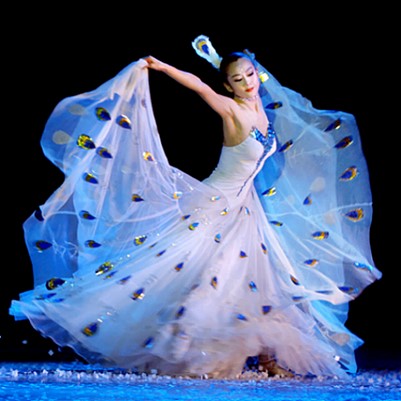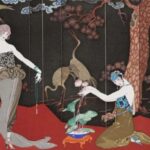Ran Zhang, The Jin Hui Music School, Hunan University of Science and Technology, Xiangtan, Hunan, China
In the ancient East, there is such an art form, which not only carries the soul of the nation, but also contains the profound religious philosophy and mysticism color. This is the Chinese folk dance – a body language that spans time and space and talks with heaven and earth. Today, we will take you into a little-known art world, exploring the religious beliefs and mysteries that flow through the dance steps, a topic discussed in the article On the Religious Philosophy and Mysticism Elements in Chinese Folk Dance, published in the journal Trans/Form/Ação.
Dance is a very symbolic human spiritual and cultural phenomenon. Through the human body symbol, it uses the dance form, dance rhyme, dance preface, dance paragraph and dance eyes. Chinese folk dance, as an important part of Chinese national culture, is not only a form of artistic expression, but also a spiritual inheritance. With its unique charm, it shows the essence of the history and culture of various Chinese ethnic groups, integrates religious philosophy and mysticism, and embodies the profound spiritual significance and the psychological growth of human beings. As in the Dictionary of Brief Cultural Anthropology, ritual is defined as: “Take a series of symbolic actions according to a certain cultural tradition Centralized arrangements or procedures” (Chen, 1990, p. 135).
“In China, dance is often accompanied by religious activities such as festivals, parade and gatherings, and initiation ceremonies” (Barfield, 1997, p. 410). This not only enriches the content and form of dance, but also highlights the social and spiritual value of dance. Through dancing, we can have a glimpse of the ancient people’s reverence and understanding of heaven and earth, life and divinity. For example, in northern Shaanxi, China, Shaanbei Ansai Waist Drum ethnic dance is not only a folk dance deeply loved by the people, but also a ritual activity with rich cultural connotation and social significance.
Ansai is located in the northern part of the Loess Plateau, near the Inner Mongolia Plateau. The climate conditions are harsh, cold and windy, and residents are vulnerable to typhoid fever. Due to the low level of productivity, people’s ability to transform nature is weak, and it is difficult to get rid of the constraints of natural conditions. Subsequently, witchcraft activities also became prevalent, and gradually evolved into a common social phenomenon. In this religious culture ecology, “drum” is used for religious etiquette as a religious ritual vessel. People tied the red drum in the waist to threaten evil, but also used its sound to dispel the plague and ward away evil refuge for a long time. This practice contributed to the formation of today’s Shaanbei Ansai Waist Drum ethnic dance (Li, 2023, p. 95).

Image: BigBigWork.
Mysticism, a philosophical idea that explores the relationship between man and nature and man and the universe, is vividly embodied in folk dance. Also taking Shaanbei Ansai Waist Drum ethnic dance as an example, this folk dance inherits some elements of the ritual in form.
For example, in the performance of the waist drum, the performance of the drummers is sometimes as magnificent and free as a horse; sometimes as light and flexible as a dragonfly. Their dance moves transition smoothly, while maintaining the coordination of the group dance. Through specific movements and rituals, they convey the awe of nature and the universe, as well as the exploration of the mysteries of life. This way of expression not only adds a layer of mystery to the dance art, but also provides the audience with a spiritual enjoyment and thinking.
At the same time, in this series of rhythmic drums, the drummer, with their exquisite skills and tacit cooperation, showed the audience a rich folk culture and sacrificial tradition patterns. Their movements and formation changes, as if in telling an ancient story, to bring the audience into a mysterious ceremony. With the ups and downs of the drums, the audience can see patterns such as “God Tower” and “Monk Visiting the Gate”, which are not only the reproduction of folk sacrificial activities, but also the inheritance of traditional culture. Through the body language and formation changes of the drummer, they vividly present the ancient sacrificial ceremonies in front of the audience, making people feel the awe of the gods and the prayer for life.
The display of these patterns is not only a visual enjoyment, but also a spiritual touch. They allow people to appreciate the performance while also feeling the belief and hope deeply rooted in the people. Whether it is the commemoration of the war, or the yearning for a better life, these patterns all carry people’s various expectations and blessings for life. Through such a performance, the drummers not only showed their love and respect for the traditional art, but also passed on the ancient spirit of folk sacrifice to every audience. This spirit, like the sound of drums, through time and space, stirring people, so that people in the modern society, can still feel the share from the ancient sacred and solemn.
Chinese folk dance, as a unique cultural phenomenon, has a charm that extends far beyond the stage. It is the witness of history, the embodiment of the national spirit, but also the profound human thinking on life, nature and the universe. Let’s walk into this article together to explore the religious philosophy and mysticism of other folk dances except Shaanbei Ansai Waist Drum ethnic dance, and feel the artistic shock that transcends time and space.
We sincerely invite you to read this paper deeply and uncover the religion and mystery behind Chinese folk dance. This is not only an appreciation of art, but also a baptism of the soul. Let’s explore, think about, and pass on this precious cultural heritage together.
To read the article, access
ZHANG, R. and PU, Shi. On the Religious philosophy and mysticism elements in Chinese folk dance Trans/Form/Ação [online]. 2024, vol. 47, no. 5, e02400252 [viewed 8 October 2024]. https://doi.org/10.1590/0101-3173.2024.v47.n5.e02400252. Available from: https://www.scielo.br/j/trans/a/XvMknT8B8CfkVd4njTJfpdB
References
BARFIELD, T. The Dictionary of Anthropology. USA: Wiley-Blackwell, 1997, p. 410.
CHEN, G. Q, Dictionary of Brief Cultural Anthropology. ZJ: Zhejiang People’s Publishing House, 1990, p. 135.
LI, N. Regional cultural connotation and value interpretation of Ansai Waist Drum. Journal of Sociology and Ethnology [online]. 2023, vol. 12, no. 2, pp. 95-96 [viewed 8 October 2024]. https://doi.org/10.23977/jsoce.2023.050212. Available from: https://www.clausiuspress.com/assets/default/article/2023/04/06/article_1680838666.pdf
External links
Trans/Form/Ação – TRANS: https://www.scielo.br/trans/
Trans/Form/Ação – Journal: Instagram | Facebook | Academia.edu
About Ran Zhang
Ran Zhang, Director of the Folk Dance Department, Visiting Scholar of the Ministry of Education’s Central and Western Young Backbone Teachers, graduated from Beijing Dance Academy under the supervision of Prof. Pan Zhitao. She is mainly engaged in the teaching and research of folk dance and dance anthropology.
Como citar este post [ISO 690/2010]:



















Recent Comments